Literature Review: Use of Ubiquitous Media Systems in Business Orgs
VerifiedAdded on 2019/12/28
|9
|2842
|303
Literature Review
AI Summary
This literature review explores the evolving landscape of ubiquitous media systems within business organizations. It delves into the impact of digital media and information technology, highlighting how businesses leverage the internet and smart technologies for global reach and customer engagement. The review examines key concepts like ubiquitous computing, natural interfaces, and context-aware computing, discussing the shift from traditional computing to smart technology and the rise of digital marketing. It also covers the integration of devices like smartphones and interactive whiteboards, and the importance of security and privacy in these systems. Furthermore, the review explores applications in various fields, including health, social care, and medical sciences, and the role of ambient intelligence and smart sensors. It concludes by emphasizing the benefits of ubiquitous media in facilitating real-time interactions, enhancing communication, and enabling advanced marketing research while addressing the crucial need for privacy protection in this digital age.
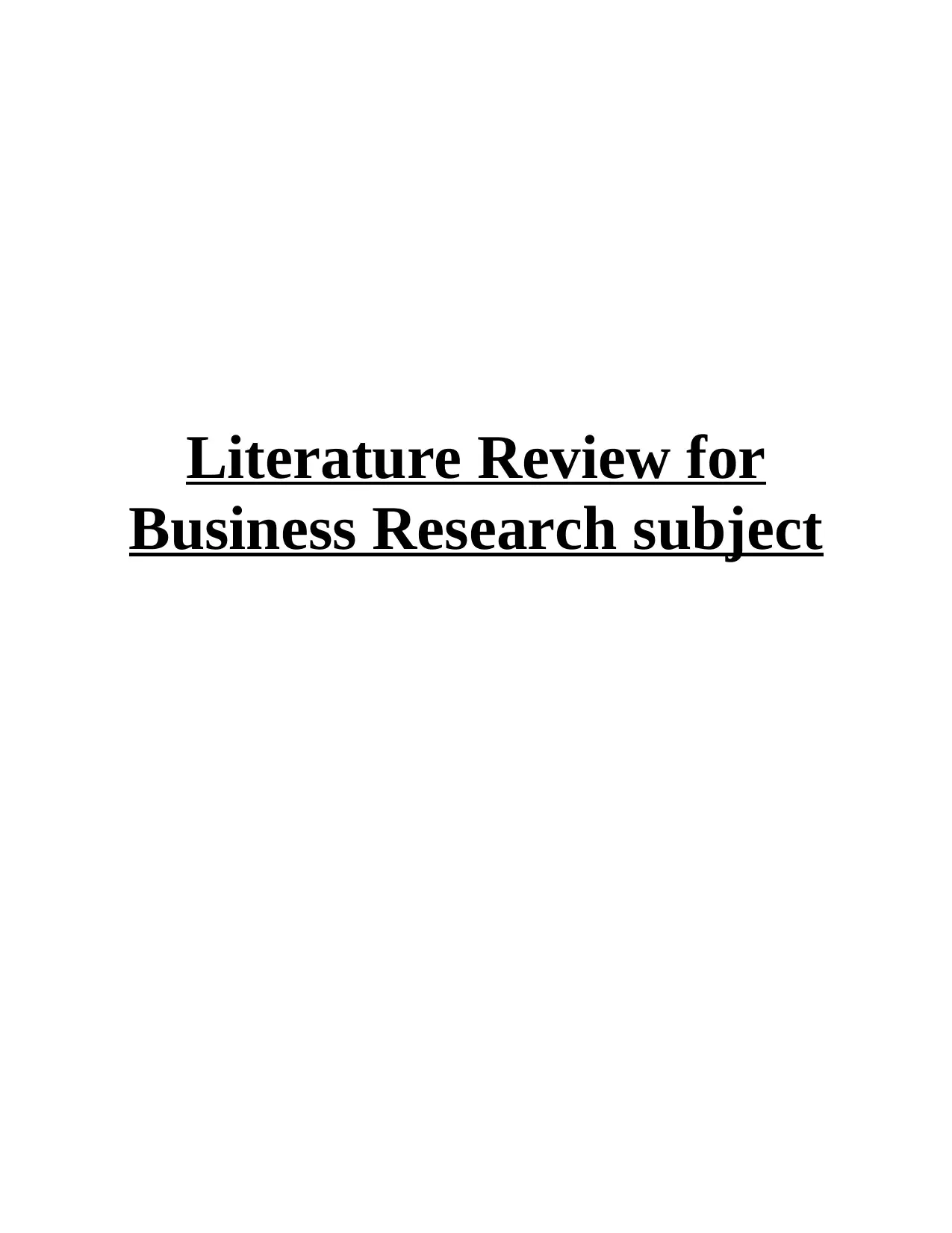
Literature Review for
Business Research subject
Business Research subject
Paraphrase This Document
Need a fresh take? Get an instant paraphrase of this document with our AI Paraphraser
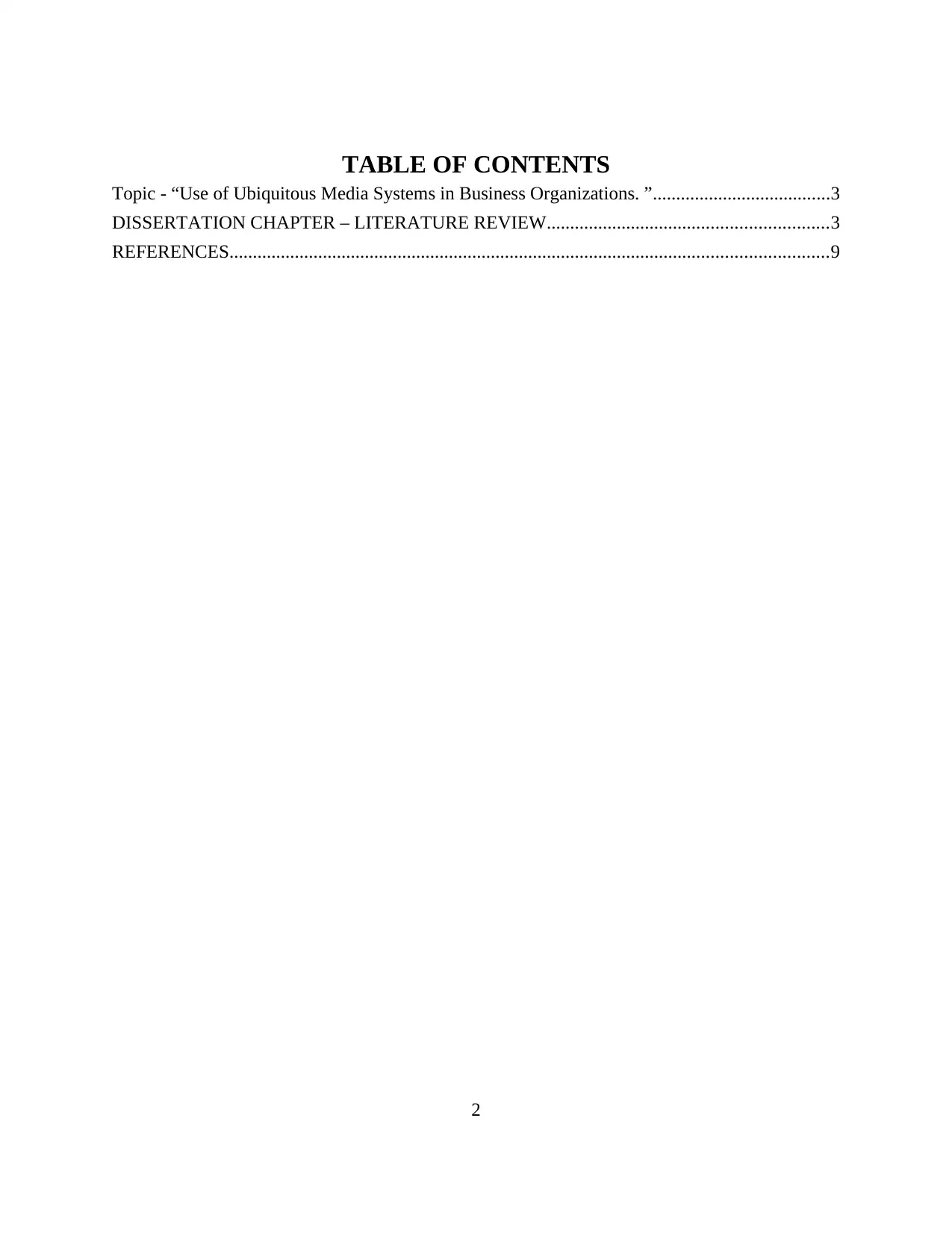
TABLE OF CONTENTS
Topic - “Use of Ubiquitous Media Systems in Business Organizations. ”......................................3
DISSERTATION CHAPTER – LITERATURE REVIEW............................................................3
REFERENCES................................................................................................................................9
2
Topic - “Use of Ubiquitous Media Systems in Business Organizations. ”......................................3
DISSERTATION CHAPTER – LITERATURE REVIEW............................................................3
REFERENCES................................................................................................................................9
2
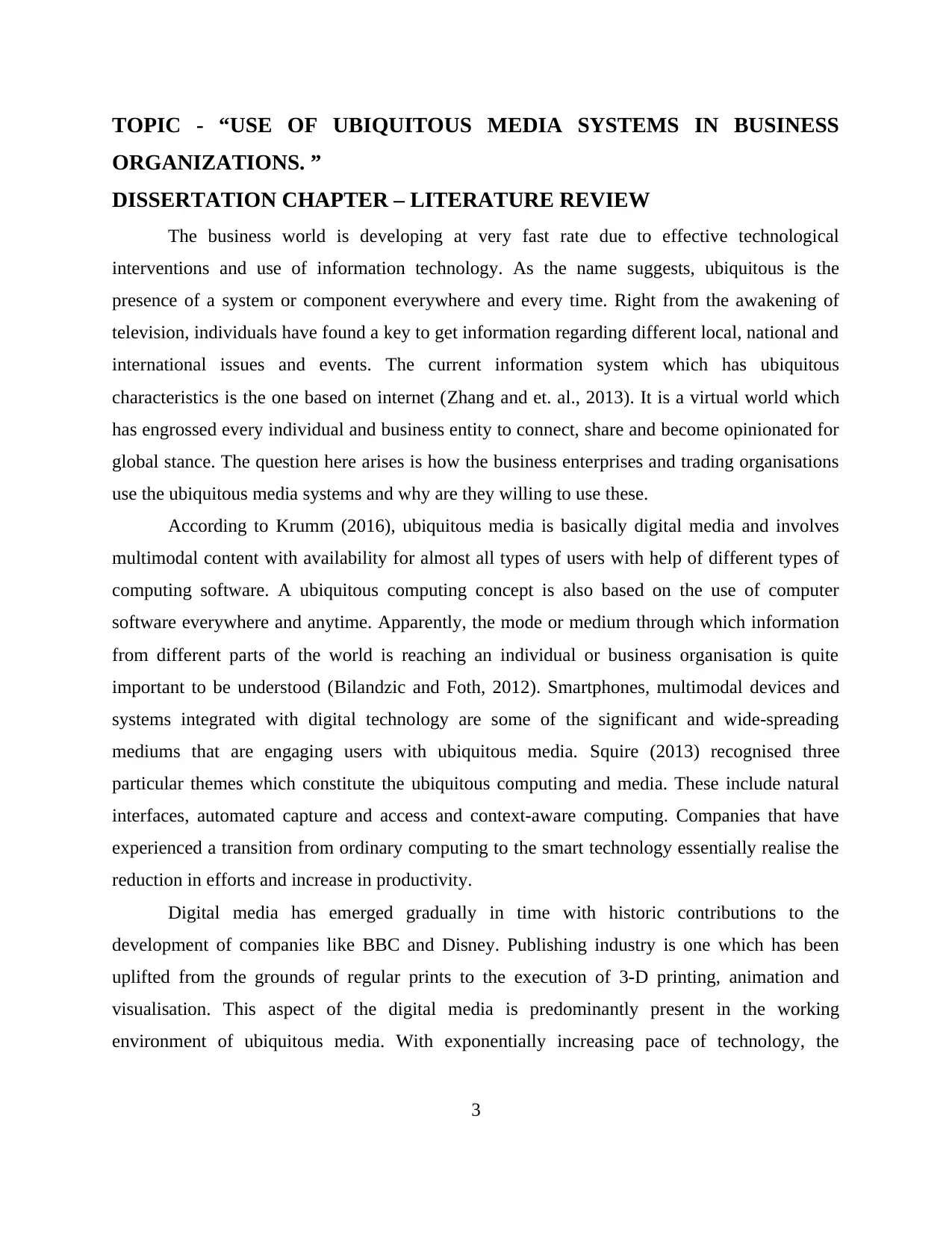
TOPIC - “USE OF UBIQUITOUS MEDIA SYSTEMS IN BUSINESS
ORGANIZATIONS. ”
DISSERTATION CHAPTER – LITERATURE REVIEW
The business world is developing at very fast rate due to effective technological
interventions and use of information technology. As the name suggests, ubiquitous is the
presence of a system or component everywhere and every time. Right from the awakening of
television, individuals have found a key to get information regarding different local, national and
international issues and events. The current information system which has ubiquitous
characteristics is the one based on internet (Zhang and et. al., 2013). It is a virtual world which
has engrossed every individual and business entity to connect, share and become opinionated for
global stance. The question here arises is how the business enterprises and trading organisations
use the ubiquitous media systems and why are they willing to use these.
According to Krumm (2016), ubiquitous media is basically digital media and involves
multimodal content with availability for almost all types of users with help of different types of
computing software. A ubiquitous computing concept is also based on the use of computer
software everywhere and anytime. Apparently, the mode or medium through which information
from different parts of the world is reaching an individual or business organisation is quite
important to be understood (Bilandzic and Foth, 2012). Smartphones, multimodal devices and
systems integrated with digital technology are some of the significant and wide-spreading
mediums that are engaging users with ubiquitous media. Squire (2013) recognised three
particular themes which constitute the ubiquitous computing and media. These include natural
interfaces, automated capture and access and context-aware computing. Companies that have
experienced a transition from ordinary computing to the smart technology essentially realise the
reduction in efforts and increase in productivity.
Digital media has emerged gradually in time with historic contributions to the
development of companies like BBC and Disney. Publishing industry is one which has been
uplifted from the grounds of regular prints to the execution of 3-D printing, animation and
visualisation. This aspect of the digital media is predominantly present in the working
environment of ubiquitous media. With exponentially increasing pace of technology, the
3
ORGANIZATIONS. ”
DISSERTATION CHAPTER – LITERATURE REVIEW
The business world is developing at very fast rate due to effective technological
interventions and use of information technology. As the name suggests, ubiquitous is the
presence of a system or component everywhere and every time. Right from the awakening of
television, individuals have found a key to get information regarding different local, national and
international issues and events. The current information system which has ubiquitous
characteristics is the one based on internet (Zhang and et. al., 2013). It is a virtual world which
has engrossed every individual and business entity to connect, share and become opinionated for
global stance. The question here arises is how the business enterprises and trading organisations
use the ubiquitous media systems and why are they willing to use these.
According to Krumm (2016), ubiquitous media is basically digital media and involves
multimodal content with availability for almost all types of users with help of different types of
computing software. A ubiquitous computing concept is also based on the use of computer
software everywhere and anytime. Apparently, the mode or medium through which information
from different parts of the world is reaching an individual or business organisation is quite
important to be understood (Bilandzic and Foth, 2012). Smartphones, multimodal devices and
systems integrated with digital technology are some of the significant and wide-spreading
mediums that are engaging users with ubiquitous media. Squire (2013) recognised three
particular themes which constitute the ubiquitous computing and media. These include natural
interfaces, automated capture and access and context-aware computing. Companies that have
experienced a transition from ordinary computing to the smart technology essentially realise the
reduction in efforts and increase in productivity.
Digital media has emerged gradually in time with historic contributions to the
development of companies like BBC and Disney. Publishing industry is one which has been
uplifted from the grounds of regular prints to the execution of 3-D printing, animation and
visualisation. This aspect of the digital media is predominantly present in the working
environment of ubiquitous media. With exponentially increasing pace of technology, the
3
⊘ This is a preview!⊘
Do you want full access?
Subscribe today to unlock all pages.

Trusted by 1+ million students worldwide
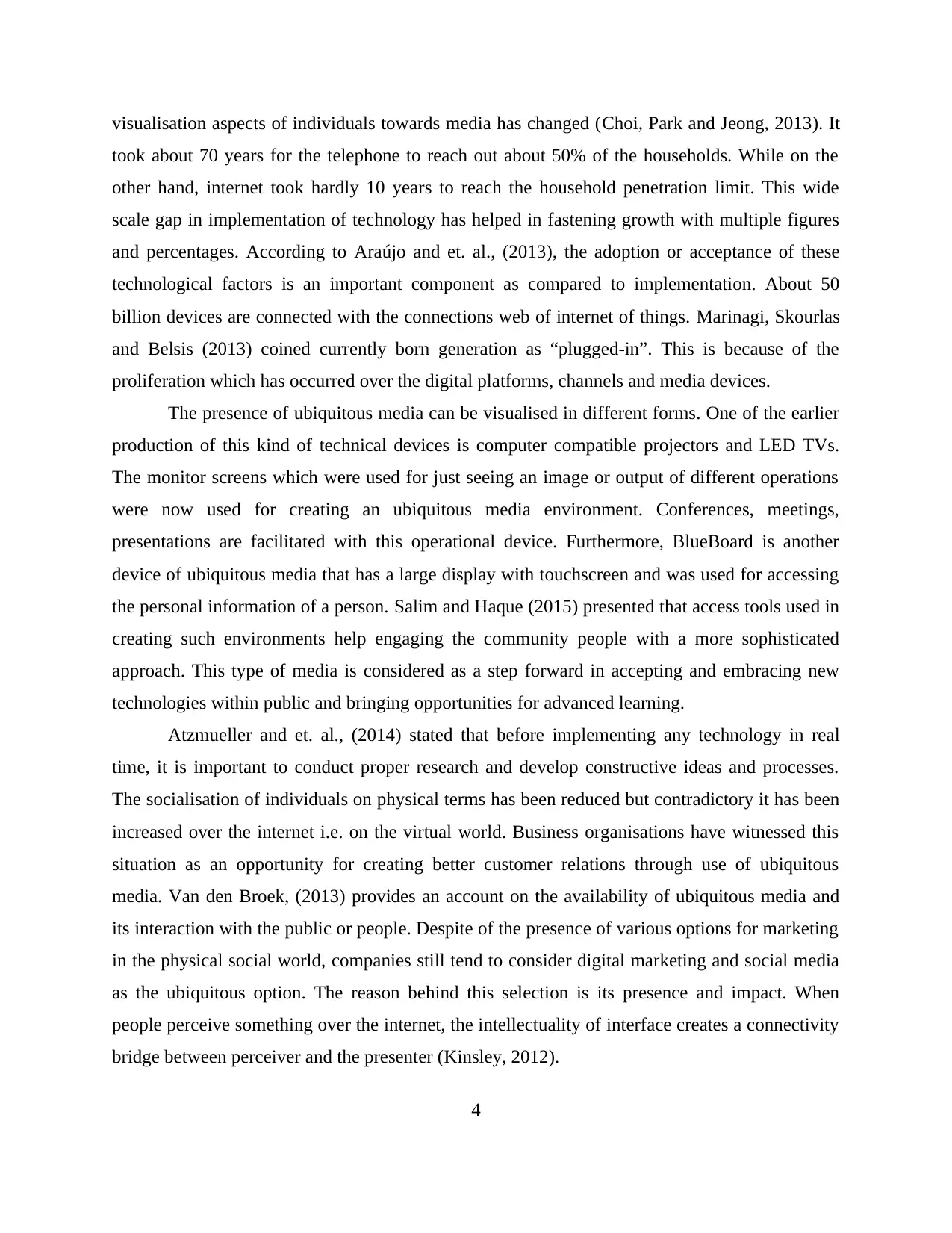
visualisation aspects of individuals towards media has changed (Choi, Park and Jeong, 2013). It
took about 70 years for the telephone to reach out about 50% of the households. While on the
other hand, internet took hardly 10 years to reach the household penetration limit. This wide
scale gap in implementation of technology has helped in fastening growth with multiple figures
and percentages. According to Araújo and et. al., (2013), the adoption or acceptance of these
technological factors is an important component as compared to implementation. About 50
billion devices are connected with the connections web of internet of things. Marinagi, Skourlas
and Belsis (2013) coined currently born generation as “plugged-in”. This is because of the
proliferation which has occurred over the digital platforms, channels and media devices.
The presence of ubiquitous media can be visualised in different forms. One of the earlier
production of this kind of technical devices is computer compatible projectors and LED TVs.
The monitor screens which were used for just seeing an image or output of different operations
were now used for creating an ubiquitous media environment. Conferences, meetings,
presentations are facilitated with this operational device. Furthermore, BlueBoard is another
device of ubiquitous media that has a large display with touchscreen and was used for accessing
the personal information of a person. Salim and Haque (2015) presented that access tools used in
creating such environments help engaging the community people with a more sophisticated
approach. This type of media is considered as a step forward in accepting and embracing new
technologies within public and bringing opportunities for advanced learning.
Atzmueller and et. al., (2014) stated that before implementing any technology in real
time, it is important to conduct proper research and develop constructive ideas and processes.
The socialisation of individuals on physical terms has been reduced but contradictory it has been
increased over the internet i.e. on the virtual world. Business organisations have witnessed this
situation as an opportunity for creating better customer relations through use of ubiquitous
media. Van den Broek, (2013) provides an account on the availability of ubiquitous media and
its interaction with the public or people. Despite of the presence of various options for marketing
in the physical social world, companies still tend to consider digital marketing and social media
as the ubiquitous option. The reason behind this selection is its presence and impact. When
people perceive something over the internet, the intellectuality of interface creates a connectivity
bridge between perceiver and the presenter (Kinsley, 2012).
4
took about 70 years for the telephone to reach out about 50% of the households. While on the
other hand, internet took hardly 10 years to reach the household penetration limit. This wide
scale gap in implementation of technology has helped in fastening growth with multiple figures
and percentages. According to Araújo and et. al., (2013), the adoption or acceptance of these
technological factors is an important component as compared to implementation. About 50
billion devices are connected with the connections web of internet of things. Marinagi, Skourlas
and Belsis (2013) coined currently born generation as “plugged-in”. This is because of the
proliferation which has occurred over the digital platforms, channels and media devices.
The presence of ubiquitous media can be visualised in different forms. One of the earlier
production of this kind of technical devices is computer compatible projectors and LED TVs.
The monitor screens which were used for just seeing an image or output of different operations
were now used for creating an ubiquitous media environment. Conferences, meetings,
presentations are facilitated with this operational device. Furthermore, BlueBoard is another
device of ubiquitous media that has a large display with touchscreen and was used for accessing
the personal information of a person. Salim and Haque (2015) presented that access tools used in
creating such environments help engaging the community people with a more sophisticated
approach. This type of media is considered as a step forward in accepting and embracing new
technologies within public and bringing opportunities for advanced learning.
Atzmueller and et. al., (2014) stated that before implementing any technology in real
time, it is important to conduct proper research and develop constructive ideas and processes.
The socialisation of individuals on physical terms has been reduced but contradictory it has been
increased over the internet i.e. on the virtual world. Business organisations have witnessed this
situation as an opportunity for creating better customer relations through use of ubiquitous
media. Van den Broek, (2013) provides an account on the availability of ubiquitous media and
its interaction with the public or people. Despite of the presence of various options for marketing
in the physical social world, companies still tend to consider digital marketing and social media
as the ubiquitous option. The reason behind this selection is its presence and impact. When
people perceive something over the internet, the intellectuality of interface creates a connectivity
bridge between perceiver and the presenter (Kinsley, 2012).
4
Paraphrase This Document
Need a fresh take? Get an instant paraphrase of this document with our AI Paraphraser
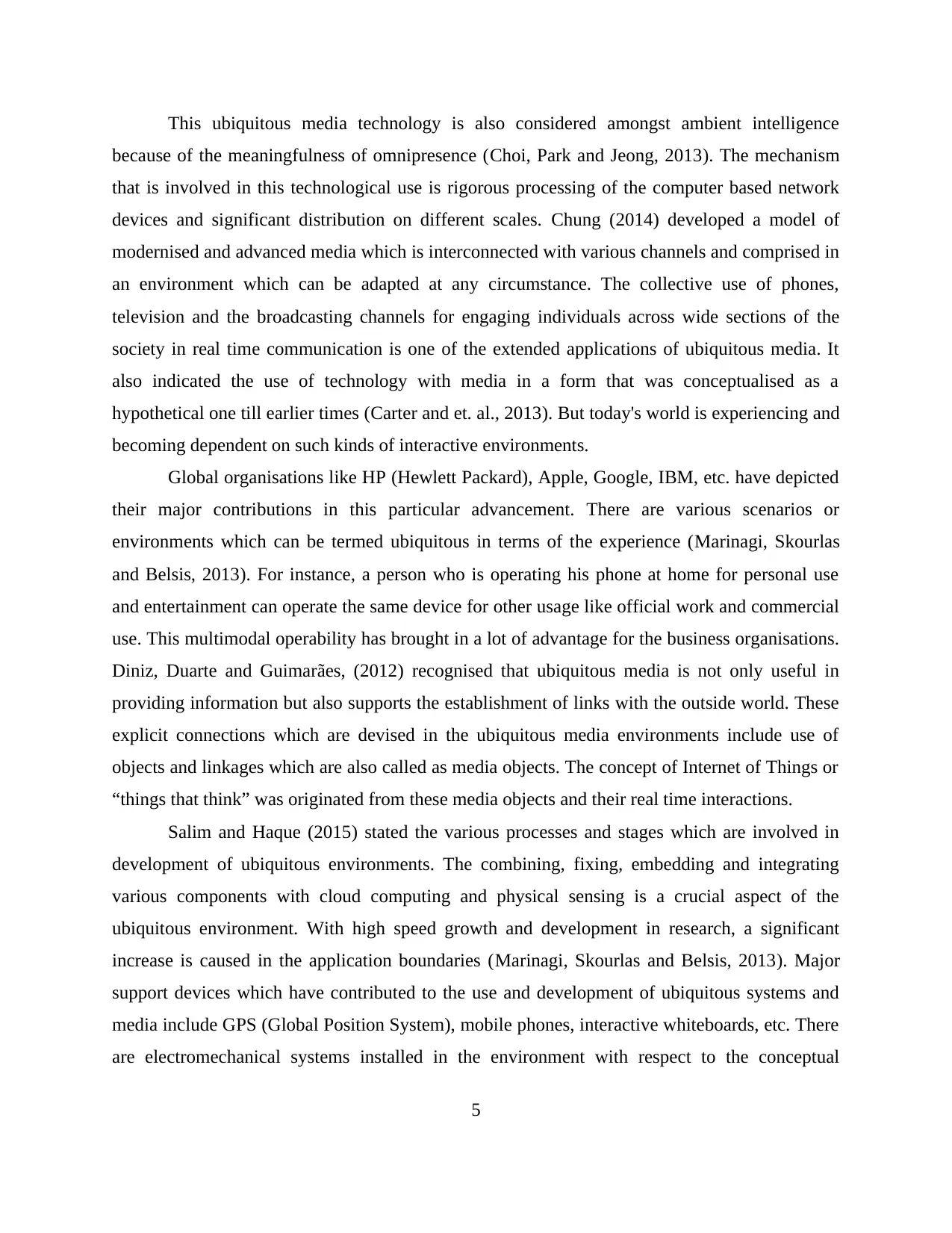
This ubiquitous media technology is also considered amongst ambient intelligence
because of the meaningfulness of omnipresence (Choi, Park and Jeong, 2013). The mechanism
that is involved in this technological use is rigorous processing of the computer based network
devices and significant distribution on different scales. Chung (2014) developed a model of
modernised and advanced media which is interconnected with various channels and comprised in
an environment which can be adapted at any circumstance. The collective use of phones,
television and the broadcasting channels for engaging individuals across wide sections of the
society in real time communication is one of the extended applications of ubiquitous media. It
also indicated the use of technology with media in a form that was conceptualised as a
hypothetical one till earlier times (Carter and et. al., 2013). But today's world is experiencing and
becoming dependent on such kinds of interactive environments.
Global organisations like HP (Hewlett Packard), Apple, Google, IBM, etc. have depicted
their major contributions in this particular advancement. There are various scenarios or
environments which can be termed ubiquitous in terms of the experience (Marinagi, Skourlas
and Belsis, 2013). For instance, a person who is operating his phone at home for personal use
and entertainment can operate the same device for other usage like official work and commercial
use. This multimodal operability has brought in a lot of advantage for the business organisations.
Diniz, Duarte and Guimarães, (2012) recognised that ubiquitous media is not only useful in
providing information but also supports the establishment of links with the outside world. These
explicit connections which are devised in the ubiquitous media environments include use of
objects and linkages which are also called as media objects. The concept of Internet of Things or
“things that think” was originated from these media objects and their real time interactions.
Salim and Haque (2015) stated the various processes and stages which are involved in
development of ubiquitous environments. The combining, fixing, embedding and integrating
various components with cloud computing and physical sensing is a crucial aspect of the
ubiquitous environment. With high speed growth and development in research, a significant
increase is caused in the application boundaries (Marinagi, Skourlas and Belsis, 2013). Major
support devices which have contributed to the use and development of ubiquitous systems and
media include GPS (Global Position System), mobile phones, interactive whiteboards, etc. There
are electromechanical systems installed in the environment with respect to the conceptual
5
because of the meaningfulness of omnipresence (Choi, Park and Jeong, 2013). The mechanism
that is involved in this technological use is rigorous processing of the computer based network
devices and significant distribution on different scales. Chung (2014) developed a model of
modernised and advanced media which is interconnected with various channels and comprised in
an environment which can be adapted at any circumstance. The collective use of phones,
television and the broadcasting channels for engaging individuals across wide sections of the
society in real time communication is one of the extended applications of ubiquitous media. It
also indicated the use of technology with media in a form that was conceptualised as a
hypothetical one till earlier times (Carter and et. al., 2013). But today's world is experiencing and
becoming dependent on such kinds of interactive environments.
Global organisations like HP (Hewlett Packard), Apple, Google, IBM, etc. have depicted
their major contributions in this particular advancement. There are various scenarios or
environments which can be termed ubiquitous in terms of the experience (Marinagi, Skourlas
and Belsis, 2013). For instance, a person who is operating his phone at home for personal use
and entertainment can operate the same device for other usage like official work and commercial
use. This multimodal operability has brought in a lot of advantage for the business organisations.
Diniz, Duarte and Guimarães, (2012) recognised that ubiquitous media is not only useful in
providing information but also supports the establishment of links with the outside world. These
explicit connections which are devised in the ubiquitous media environments include use of
objects and linkages which are also called as media objects. The concept of Internet of Things or
“things that think” was originated from these media objects and their real time interactions.
Salim and Haque (2015) stated the various processes and stages which are involved in
development of ubiquitous environments. The combining, fixing, embedding and integrating
various components with cloud computing and physical sensing is a crucial aspect of the
ubiquitous environment. With high speed growth and development in research, a significant
increase is caused in the application boundaries (Marinagi, Skourlas and Belsis, 2013). Major
support devices which have contributed to the use and development of ubiquitous systems and
media include GPS (Global Position System), mobile phones, interactive whiteboards, etc. There
are electromechanical systems installed in the environment with respect to the conceptual
5
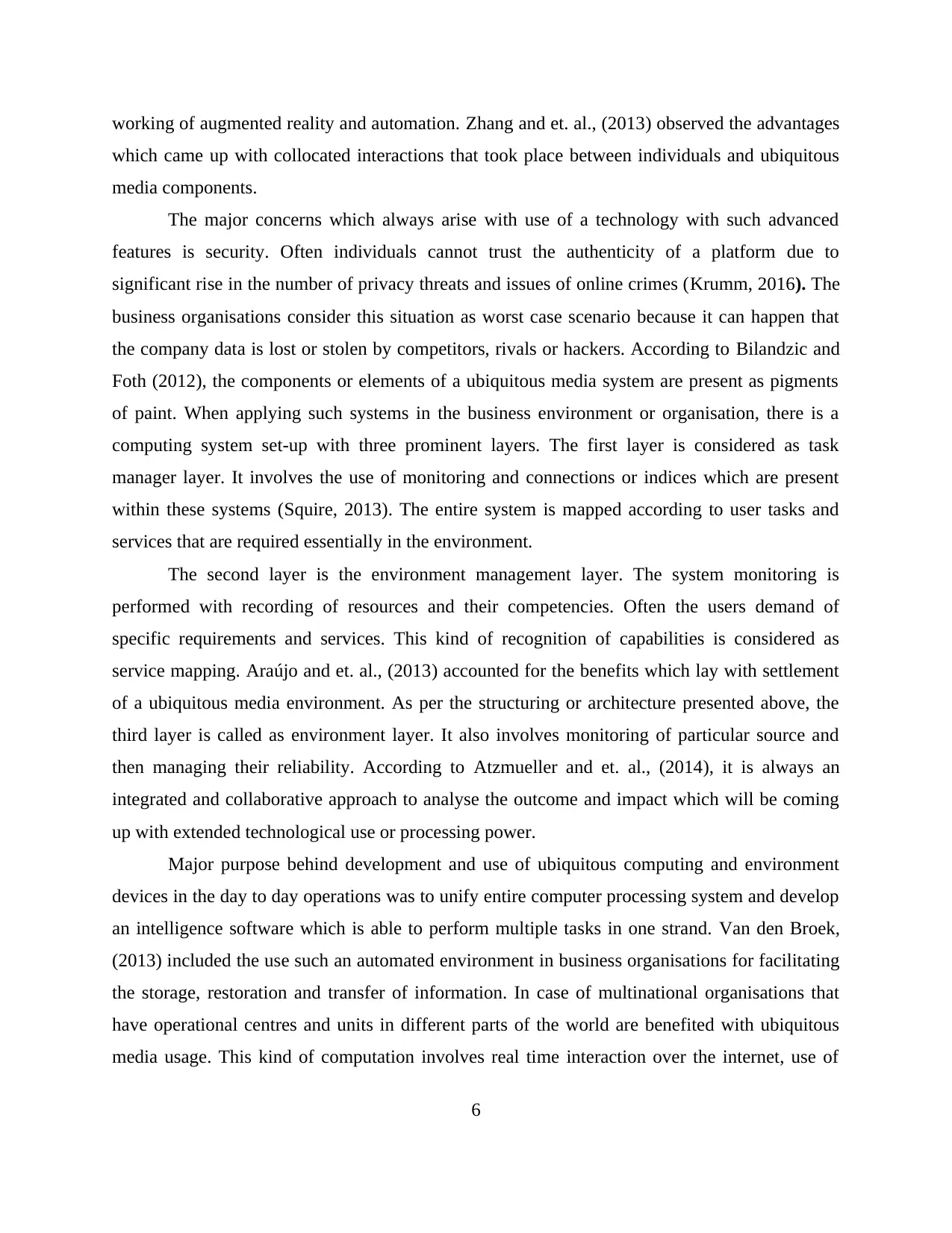
working of augmented reality and automation. Zhang and et. al., (2013) observed the advantages
which came up with collocated interactions that took place between individuals and ubiquitous
media components.
The major concerns which always arise with use of a technology with such advanced
features is security. Often individuals cannot trust the authenticity of a platform due to
significant rise in the number of privacy threats and issues of online crimes (Krumm, 2016). The
business organisations consider this situation as worst case scenario because it can happen that
the company data is lost or stolen by competitors, rivals or hackers. According to Bilandzic and
Foth (2012), the components or elements of a ubiquitous media system are present as pigments
of paint. When applying such systems in the business environment or organisation, there is a
computing system set-up with three prominent layers. The first layer is considered as task
manager layer. It involves the use of monitoring and connections or indices which are present
within these systems (Squire, 2013). The entire system is mapped according to user tasks and
services that are required essentially in the environment.
The second layer is the environment management layer. The system monitoring is
performed with recording of resources and their competencies. Often the users demand of
specific requirements and services. This kind of recognition of capabilities is considered as
service mapping. Araújo and et. al., (2013) accounted for the benefits which lay with settlement
of a ubiquitous media environment. As per the structuring or architecture presented above, the
third layer is called as environment layer. It also involves monitoring of particular source and
then managing their reliability. According to Atzmueller and et. al., (2014), it is always an
integrated and collaborative approach to analyse the outcome and impact which will be coming
up with extended technological use or processing power.
Major purpose behind development and use of ubiquitous computing and environment
devices in the day to day operations was to unify entire computer processing system and develop
an intelligence software which is able to perform multiple tasks in one strand. Van den Broek,
(2013) included the use such an automated environment in business organisations for facilitating
the storage, restoration and transfer of information. In case of multinational organisations that
have operational centres and units in different parts of the world are benefited with ubiquitous
media usage. This kind of computation involves real time interaction over the internet, use of
6
which came up with collocated interactions that took place between individuals and ubiquitous
media components.
The major concerns which always arise with use of a technology with such advanced
features is security. Often individuals cannot trust the authenticity of a platform due to
significant rise in the number of privacy threats and issues of online crimes (Krumm, 2016). The
business organisations consider this situation as worst case scenario because it can happen that
the company data is lost or stolen by competitors, rivals or hackers. According to Bilandzic and
Foth (2012), the components or elements of a ubiquitous media system are present as pigments
of paint. When applying such systems in the business environment or organisation, there is a
computing system set-up with three prominent layers. The first layer is considered as task
manager layer. It involves the use of monitoring and connections or indices which are present
within these systems (Squire, 2013). The entire system is mapped according to user tasks and
services that are required essentially in the environment.
The second layer is the environment management layer. The system monitoring is
performed with recording of resources and their competencies. Often the users demand of
specific requirements and services. This kind of recognition of capabilities is considered as
service mapping. Araújo and et. al., (2013) accounted for the benefits which lay with settlement
of a ubiquitous media environment. As per the structuring or architecture presented above, the
third layer is called as environment layer. It also involves monitoring of particular source and
then managing their reliability. According to Atzmueller and et. al., (2014), it is always an
integrated and collaborative approach to analyse the outcome and impact which will be coming
up with extended technological use or processing power.
Major purpose behind development and use of ubiquitous computing and environment
devices in the day to day operations was to unify entire computer processing system and develop
an intelligence software which is able to perform multiple tasks in one strand. Van den Broek,
(2013) included the use such an automated environment in business organisations for facilitating
the storage, restoration and transfer of information. In case of multinational organisations that
have operational centres and units in different parts of the world are benefited with ubiquitous
media usage. This kind of computation involves real time interaction over the internet, use of
6
⊘ This is a preview!⊘
Do you want full access?
Subscribe today to unlock all pages.

Trusted by 1+ million students worldwide
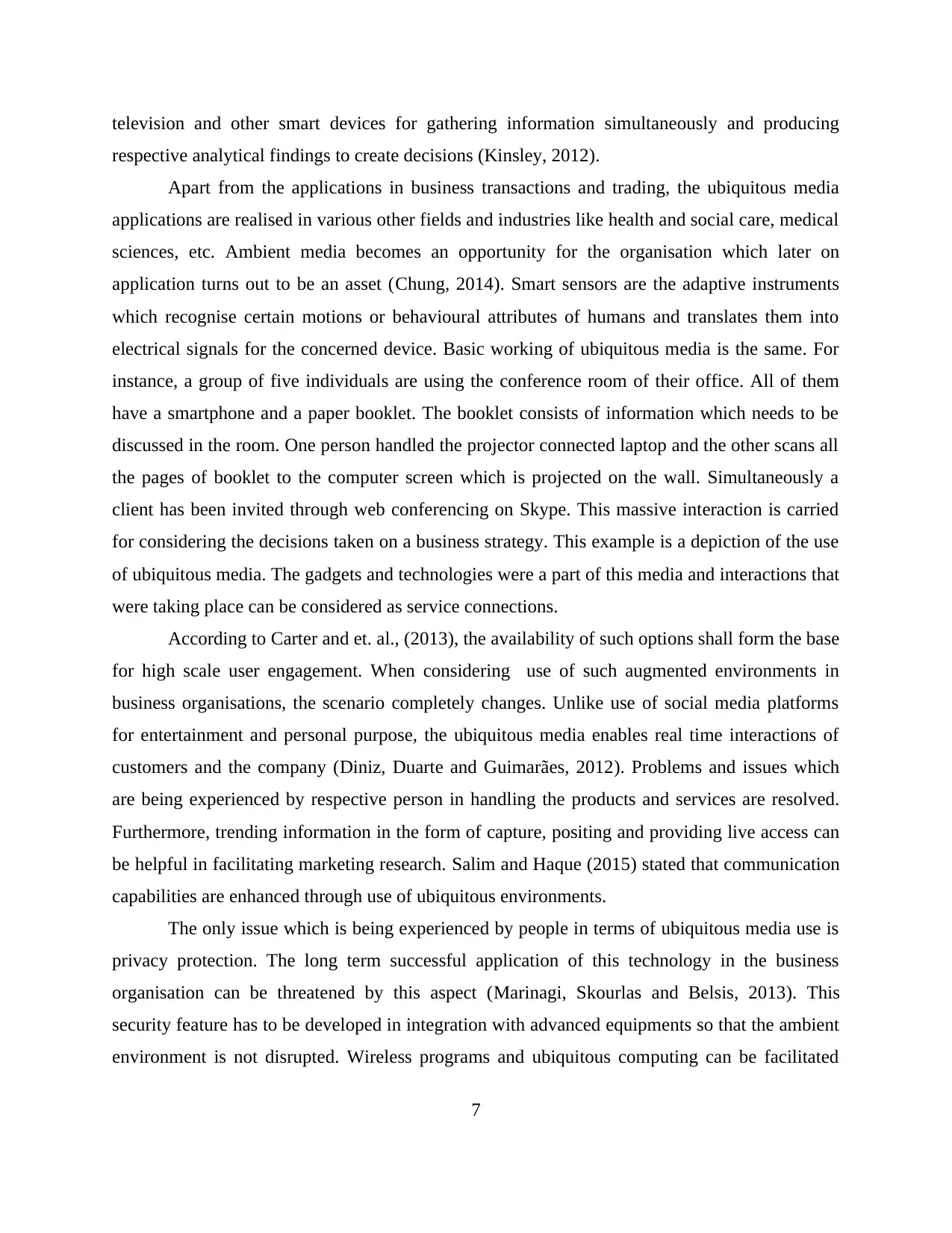
television and other smart devices for gathering information simultaneously and producing
respective analytical findings to create decisions (Kinsley, 2012).
Apart from the applications in business transactions and trading, the ubiquitous media
applications are realised in various other fields and industries like health and social care, medical
sciences, etc. Ambient media becomes an opportunity for the organisation which later on
application turns out to be an asset (Chung, 2014). Smart sensors are the adaptive instruments
which recognise certain motions or behavioural attributes of humans and translates them into
electrical signals for the concerned device. Basic working of ubiquitous media is the same. For
instance, a group of five individuals are using the conference room of their office. All of them
have a smartphone and a paper booklet. The booklet consists of information which needs to be
discussed in the room. One person handled the projector connected laptop and the other scans all
the pages of booklet to the computer screen which is projected on the wall. Simultaneously a
client has been invited through web conferencing on Skype. This massive interaction is carried
for considering the decisions taken on a business strategy. This example is a depiction of the use
of ubiquitous media. The gadgets and technologies were a part of this media and interactions that
were taking place can be considered as service connections.
According to Carter and et. al., (2013), the availability of such options shall form the base
for high scale user engagement. When considering use of such augmented environments in
business organisations, the scenario completely changes. Unlike use of social media platforms
for entertainment and personal purpose, the ubiquitous media enables real time interactions of
customers and the company (Diniz, Duarte and Guimarães, 2012). Problems and issues which
are being experienced by respective person in handling the products and services are resolved.
Furthermore, trending information in the form of capture, positing and providing live access can
be helpful in facilitating marketing research. Salim and Haque (2015) stated that communication
capabilities are enhanced through use of ubiquitous environments.
The only issue which is being experienced by people in terms of ubiquitous media use is
privacy protection. The long term successful application of this technology in the business
organisation can be threatened by this aspect (Marinagi, Skourlas and Belsis, 2013). This
security feature has to be developed in integration with advanced equipments so that the ambient
environment is not disrupted. Wireless programs and ubiquitous computing can be facilitated
7
respective analytical findings to create decisions (Kinsley, 2012).
Apart from the applications in business transactions and trading, the ubiquitous media
applications are realised in various other fields and industries like health and social care, medical
sciences, etc. Ambient media becomes an opportunity for the organisation which later on
application turns out to be an asset (Chung, 2014). Smart sensors are the adaptive instruments
which recognise certain motions or behavioural attributes of humans and translates them into
electrical signals for the concerned device. Basic working of ubiquitous media is the same. For
instance, a group of five individuals are using the conference room of their office. All of them
have a smartphone and a paper booklet. The booklet consists of information which needs to be
discussed in the room. One person handled the projector connected laptop and the other scans all
the pages of booklet to the computer screen which is projected on the wall. Simultaneously a
client has been invited through web conferencing on Skype. This massive interaction is carried
for considering the decisions taken on a business strategy. This example is a depiction of the use
of ubiquitous media. The gadgets and technologies were a part of this media and interactions that
were taking place can be considered as service connections.
According to Carter and et. al., (2013), the availability of such options shall form the base
for high scale user engagement. When considering use of such augmented environments in
business organisations, the scenario completely changes. Unlike use of social media platforms
for entertainment and personal purpose, the ubiquitous media enables real time interactions of
customers and the company (Diniz, Duarte and Guimarães, 2012). Problems and issues which
are being experienced by respective person in handling the products and services are resolved.
Furthermore, trending information in the form of capture, positing and providing live access can
be helpful in facilitating marketing research. Salim and Haque (2015) stated that communication
capabilities are enhanced through use of ubiquitous environments.
The only issue which is being experienced by people in terms of ubiquitous media use is
privacy protection. The long term successful application of this technology in the business
organisation can be threatened by this aspect (Marinagi, Skourlas and Belsis, 2013). This
security feature has to be developed in integration with advanced equipments so that the ambient
environment is not disrupted. Wireless programs and ubiquitous computing can be facilitated
7
Paraphrase This Document
Need a fresh take? Get an instant paraphrase of this document with our AI Paraphraser
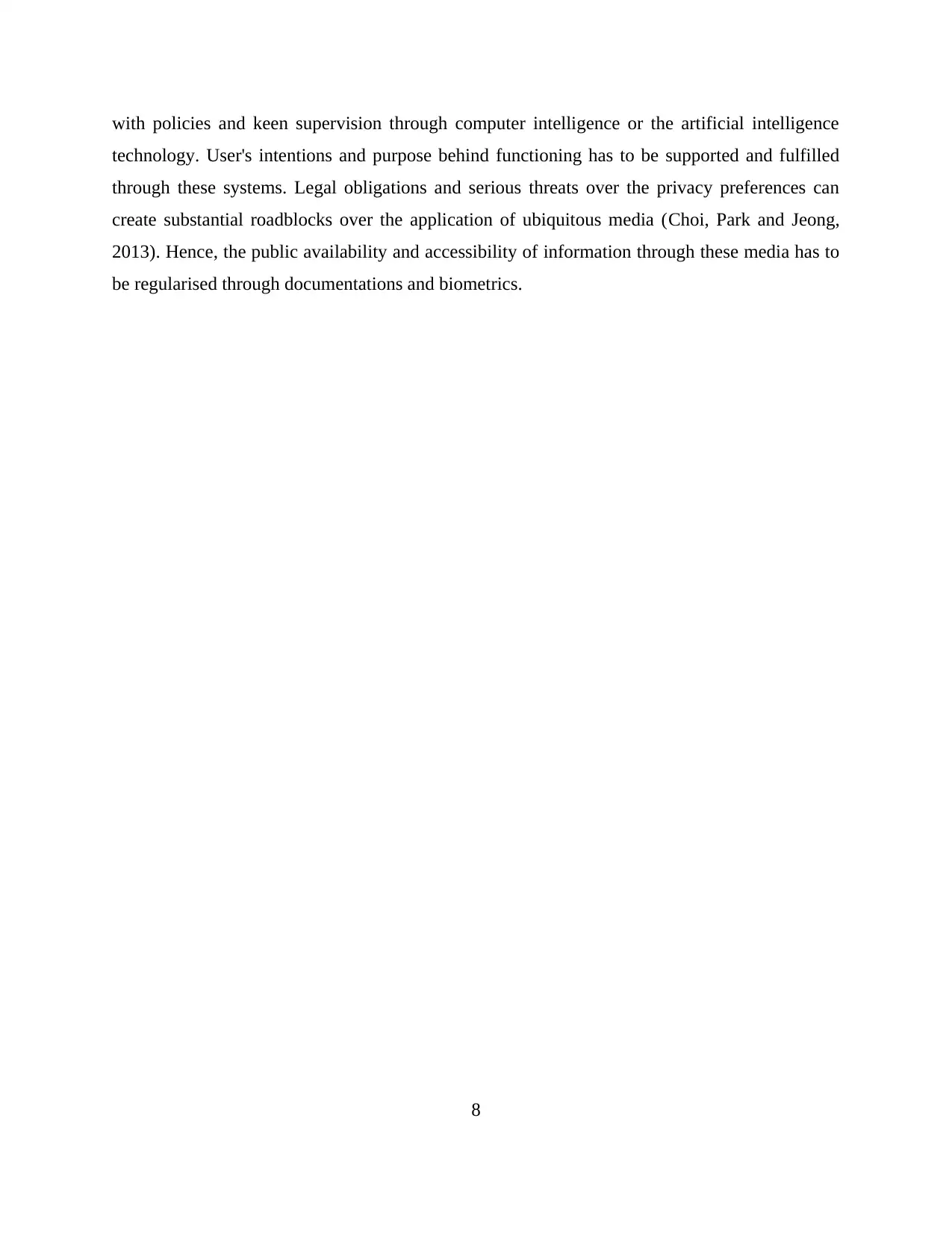
with policies and keen supervision through computer intelligence or the artificial intelligence
technology. User's intentions and purpose behind functioning has to be supported and fulfilled
through these systems. Legal obligations and serious threats over the privacy preferences can
create substantial roadblocks over the application of ubiquitous media (Choi, Park and Jeong,
2013). Hence, the public availability and accessibility of information through these media has to
be regularised through documentations and biometrics.
8
technology. User's intentions and purpose behind functioning has to be supported and fulfilled
through these systems. Legal obligations and serious threats over the privacy preferences can
create substantial roadblocks over the application of ubiquitous media (Choi, Park and Jeong,
2013). Hence, the public availability and accessibility of information through these media has to
be regularised through documentations and biometrics.
8
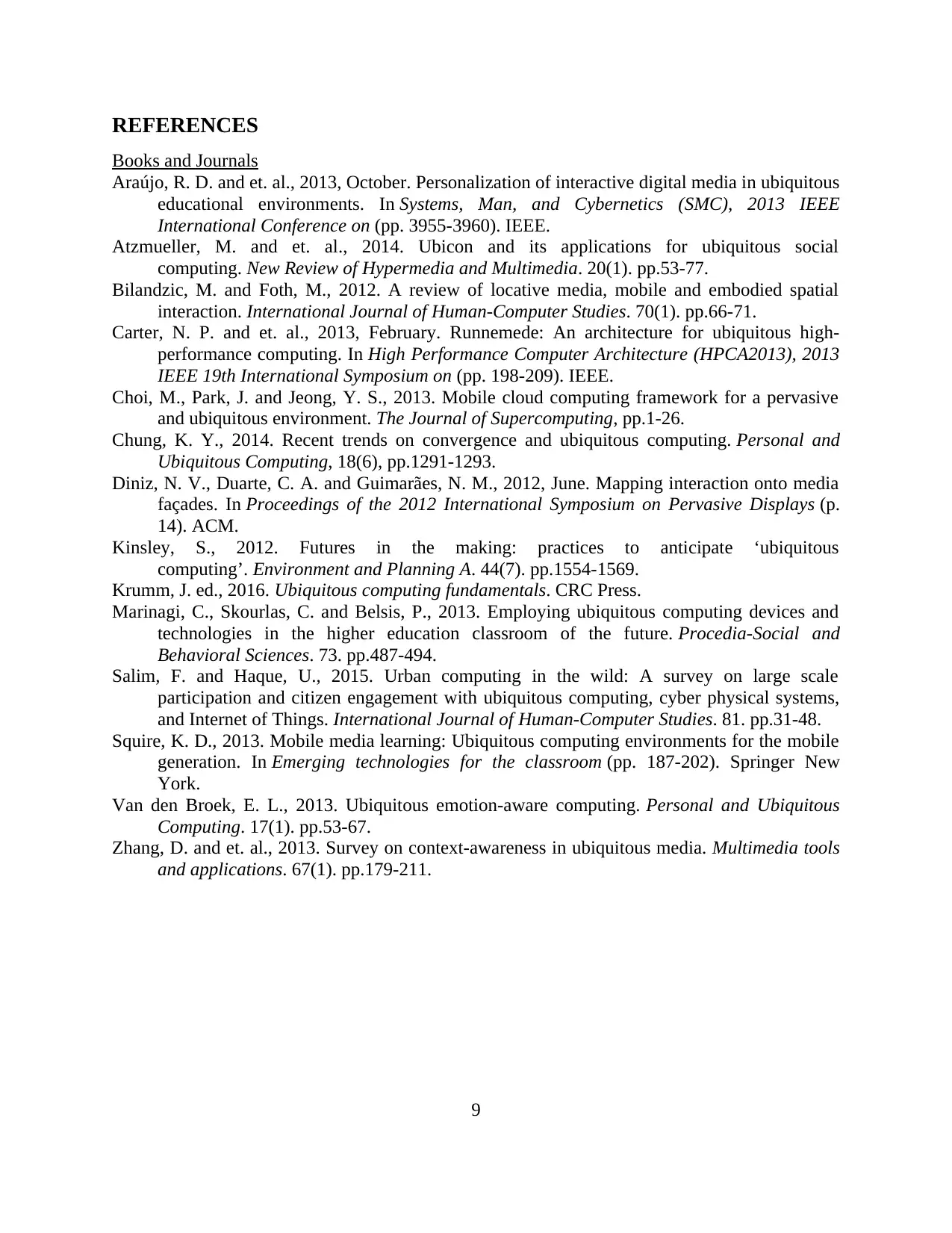
REFERENCES
Books and Journals
Araújo, R. D. and et. al., 2013, October. Personalization of interactive digital media in ubiquitous
educational environments. In Systems, Man, and Cybernetics (SMC), 2013 IEEE
International Conference on (pp. 3955-3960). IEEE.
Atzmueller, M. and et. al., 2014. Ubicon and its applications for ubiquitous social
computing. New Review of Hypermedia and Multimedia. 20(1). pp.53-77.
Bilandzic, M. and Foth, M., 2012. A review of locative media, mobile and embodied spatial
interaction. International Journal of Human-Computer Studies. 70(1). pp.66-71.
Carter, N. P. and et. al., 2013, February. Runnemede: An architecture for ubiquitous high-
performance computing. In High Performance Computer Architecture (HPCA2013), 2013
IEEE 19th International Symposium on (pp. 198-209). IEEE.
Choi, M., Park, J. and Jeong, Y. S., 2013. Mobile cloud computing framework for a pervasive
and ubiquitous environment. The Journal of Supercomputing, pp.1-26.
Chung, K. Y., 2014. Recent trends on convergence and ubiquitous computing. Personal and
Ubiquitous Computing, 18(6), pp.1291-1293.
Diniz, N. V., Duarte, C. A. and Guimarães, N. M., 2012, June. Mapping interaction onto media
façades. In Proceedings of the 2012 International Symposium on Pervasive Displays (p.
14). ACM.
Kinsley, S., 2012. Futures in the making: practices to anticipate ‘ubiquitous
computing’. Environment and Planning A. 44(7). pp.1554-1569.
Krumm, J. ed., 2016. Ubiquitous computing fundamentals. CRC Press.
Marinagi, C., Skourlas, C. and Belsis, P., 2013. Employing ubiquitous computing devices and
technologies in the higher education classroom of the future. Procedia-Social and
Behavioral Sciences. 73. pp.487-494.
Salim, F. and Haque, U., 2015. Urban computing in the wild: A survey on large scale
participation and citizen engagement with ubiquitous computing, cyber physical systems,
and Internet of Things. International Journal of Human-Computer Studies. 81. pp.31-48.
Squire, K. D., 2013. Mobile media learning: Ubiquitous computing environments for the mobile
generation. In Emerging technologies for the classroom (pp. 187-202). Springer New
York.
Van den Broek, E. L., 2013. Ubiquitous emotion-aware computing. Personal and Ubiquitous
Computing. 17(1). pp.53-67.
Zhang, D. and et. al., 2013. Survey on context-awareness in ubiquitous media. Multimedia tools
and applications. 67(1). pp.179-211.
9
Books and Journals
Araújo, R. D. and et. al., 2013, October. Personalization of interactive digital media in ubiquitous
educational environments. In Systems, Man, and Cybernetics (SMC), 2013 IEEE
International Conference on (pp. 3955-3960). IEEE.
Atzmueller, M. and et. al., 2014. Ubicon and its applications for ubiquitous social
computing. New Review of Hypermedia and Multimedia. 20(1). pp.53-77.
Bilandzic, M. and Foth, M., 2012. A review of locative media, mobile and embodied spatial
interaction. International Journal of Human-Computer Studies. 70(1). pp.66-71.
Carter, N. P. and et. al., 2013, February. Runnemede: An architecture for ubiquitous high-
performance computing. In High Performance Computer Architecture (HPCA2013), 2013
IEEE 19th International Symposium on (pp. 198-209). IEEE.
Choi, M., Park, J. and Jeong, Y. S., 2013. Mobile cloud computing framework for a pervasive
and ubiquitous environment. The Journal of Supercomputing, pp.1-26.
Chung, K. Y., 2014. Recent trends on convergence and ubiquitous computing. Personal and
Ubiquitous Computing, 18(6), pp.1291-1293.
Diniz, N. V., Duarte, C. A. and Guimarães, N. M., 2012, June. Mapping interaction onto media
façades. In Proceedings of the 2012 International Symposium on Pervasive Displays (p.
14). ACM.
Kinsley, S., 2012. Futures in the making: practices to anticipate ‘ubiquitous
computing’. Environment and Planning A. 44(7). pp.1554-1569.
Krumm, J. ed., 2016. Ubiquitous computing fundamentals. CRC Press.
Marinagi, C., Skourlas, C. and Belsis, P., 2013. Employing ubiquitous computing devices and
technologies in the higher education classroom of the future. Procedia-Social and
Behavioral Sciences. 73. pp.487-494.
Salim, F. and Haque, U., 2015. Urban computing in the wild: A survey on large scale
participation and citizen engagement with ubiquitous computing, cyber physical systems,
and Internet of Things. International Journal of Human-Computer Studies. 81. pp.31-48.
Squire, K. D., 2013. Mobile media learning: Ubiquitous computing environments for the mobile
generation. In Emerging technologies for the classroom (pp. 187-202). Springer New
York.
Van den Broek, E. L., 2013. Ubiquitous emotion-aware computing. Personal and Ubiquitous
Computing. 17(1). pp.53-67.
Zhang, D. and et. al., 2013. Survey on context-awareness in ubiquitous media. Multimedia tools
and applications. 67(1). pp.179-211.
9
⊘ This is a preview!⊘
Do you want full access?
Subscribe today to unlock all pages.

Trusted by 1+ million students worldwide
1 out of 9
Related Documents
Your All-in-One AI-Powered Toolkit for Academic Success.
+13062052269
info@desklib.com
Available 24*7 on WhatsApp / Email
![[object Object]](/_next/static/media/star-bottom.7253800d.svg)
Unlock your academic potential
Copyright © 2020–2025 A2Z Services. All Rights Reserved. Developed and managed by ZUCOL.





